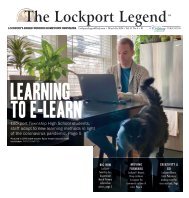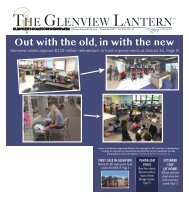You also want an ePaper? Increase the reach of your titles
YUMPU automatically turns print PDFs into web optimized ePapers that Google loves.
10 | December 2, 2020 | MALIBU SURFSIDE NEWS NEWS
malibusurfsidenews.com
It’s back to takeout, delivery
only for Malibu restaurants
POSTED TO malibusurfsidenews.com
8
DAYS AGO
SCOTT STEEPLETON, Editor
Thanksgiving Eve must
have seemed like the Bill
Murray movie “Groundhog
Day” for Malibu eateries
as they again found themselves
trapped in a time loop
where in-person dining was
banned and they were only
allowed to offer take-away
or delivery service.
The turnabout, which
will be in place for at least
three weeks and for which
Los Angeles County gave a
72-hour notice, is the latest
move in the fight against
coronavirus.
As of Monday, the county
had recorded 400,919 confirmed
cases; Malibu 156.
The city had recorded three
deaths related to the virus;
the county 7,655.
Critics say the outdoor
dining ban is based on
something other than science.
When asked by Supervisor
Kathryn Barger
during Tuesday’s Board of
Supervisors meeting how
many COVID outbreaks in
L.A. County can be traced
to restaurants, Muntu Davis,
county health officer,
could not cite a single case.
Still, some diners say local
government is acting in
the public’s interest.
“If it keeps people alive,
it’s OK with me,” Kendra
Davis, who was celebrating
a friend’s birthday Nov. 25
Diners at Tra di Noi take advantage of one of the last
seatings on Thanksgiving Eve before a three-week ban
on in-person dining — even outdoors — took effect.
SCOTT STEEPLETON/SURFSIDE NEWS
outdoors at Taverna Tony,
told Surfside News.
“We’re in the middle of a
horrible pandemic,” Davis
said. “We don’t really feel
it in Malibu, but I know
it’s very real, and innocent
people are dying.”
Like other restaurants at
Malibu Country Mart, Taverna
Tony “will be adhering
to new L.A. County guidelines
and will be pivoting
to takeout and delivery
only,” said spokeswoman
Ally Brayton. “They look
forward to reopening their
outdoor patio and indoor
dining space once permitted
by the state, county and
local officials.”
At Duke’s Malibu, Jimmy
Chavez, the general
manager, was upbeat about
how his restaurant will respond.
“We’ve got no choice but
to make the takeout model
work,” he said. “We’re going
to try a few new things
like Taco Tuesday to-go and
ride out the restrictions.”
“Hopefully we’re back up
and running for in-person
dining soon,” Chavez said.
Helene Henderson, owner
of Malibu Farm, said,
“Since all outdoor dining
has been closed down, we
will be offering ‘to-go’
only with a combined menu
from both the restaurant
and the cafe. There is a link
on our website to place togo
orders, or you can order
from the hostess stand on
the pier.”
“The pier and adjacent
beaches and beach parking
is currently open.”
Dave Knapp, general
manager at Café Habana at
Malibu Lumber Yard, told
Surfside News the entire
menu will be available togo;
no delivery.
“We have some new
items on the menu, too.”
Also to-go: the cafe’s
shaken or blended margaritas,
in Casamigos screwtop
jars.
“They’re very easy for
people to take with them,”
Knapp said.
Back at Taverna Tony,
Kendra Davis said having
food delivered suits her just
fine.
“So I don’t get to go to a
restaurant for three weeks,”
she said. “Oh, well.”
Gatherings of mixed households banned over COVID
SCOTT STEEPLETON, Editor
If you focused on the Board
of Supervisors bickering Nov.
24 over an order banning outdoor
dining to coincide with
Thanksgiving, you probably
missed county Public Health director
Barbara Ferrer laying out
a future filled with even more
restrictions.
The prohibitions that took
effect at 10 p.m. Thanksgiving
Eve are aimed at protecting
health care workers and include
forcing food establishments to
do delivery or takeout service
only.
But some, including two
county supervisors and a group
of chambers of commerce and
business organizations, called
the Coalition for Safe Reopening,
question whether limiting
what already struggling businesses
and their equally struggling
employees can do is the
wrong antidote.
In a statement announcing a
press conference in Los Angeles
decrying the board’s action,
the Coalition for Safe Reopening
called the board’s action
“arbitrary and costly” and made
“with little, if any scientific
data.”
“The results will be catastrophic
for an already struggling
business community who
are looking for alternatives such
as rapid testing in order to protect
their employees, families
and communities,” coalition
leaders said.
However, that order was only
the beginning.
During the meeting, Ferrer
previewed what’s billed as a
“targeted stay-at-home order,”
including a ban on all public
and private gatherings involving
mixed households.
Outdoor church and protests
are exempt.
While likely to go unenforced,
there would be a 10 p.m.-5 a.m.
curfew except for essential services,
and childcare, schools
and libraries could continue at
20 percent capacity.
Here’s more of what’s in
store:
• “Essential” indoor retailers
allowed to stay open at at
35 percent capacity
• “Non-essential” indoor retailers
allowed to stay open
at 20 percent capacity
• Playing outdoors, running,
swimming and biking are
OK, so long as participants
adhere to social distance
and face-cover guidelines
Gathering at beaches and
parks would be prohibited,
and pools serving more than
one residence could only offer
lap swimming. So-called nonessential
office space would
remain closed. This includes
office-based businesses, bars,
playgrounds, theaters, spectator
performances.
Youth sports could continue.
Fitness centers can continiue
operating outdoors, at 50 percent
occupancy.
The Coalition for Safe Reopening
has a three-point Economic
and Public Health Recovery
Plan, based on Gov. Gavin
Newsom’s order to temporarily
close indoor dining and operations
for restaurants in 19 counties
less than a month after allowing
them to reopen.
The plan includes:
• Requiring the state to
use emergency funds to
supplement funding for
county health departments
and enforcement divisions
that oversee adherence to
reopening regulations. That
would include authorizing
counties to grant immediate
reopening for all restaurants
and bars that demonstrate
compliance with that
county’s reopening regulations,
in accordance with
state regulations.
• Creation of a California
COVID-19 Emergency
Please see COVID, 12

















